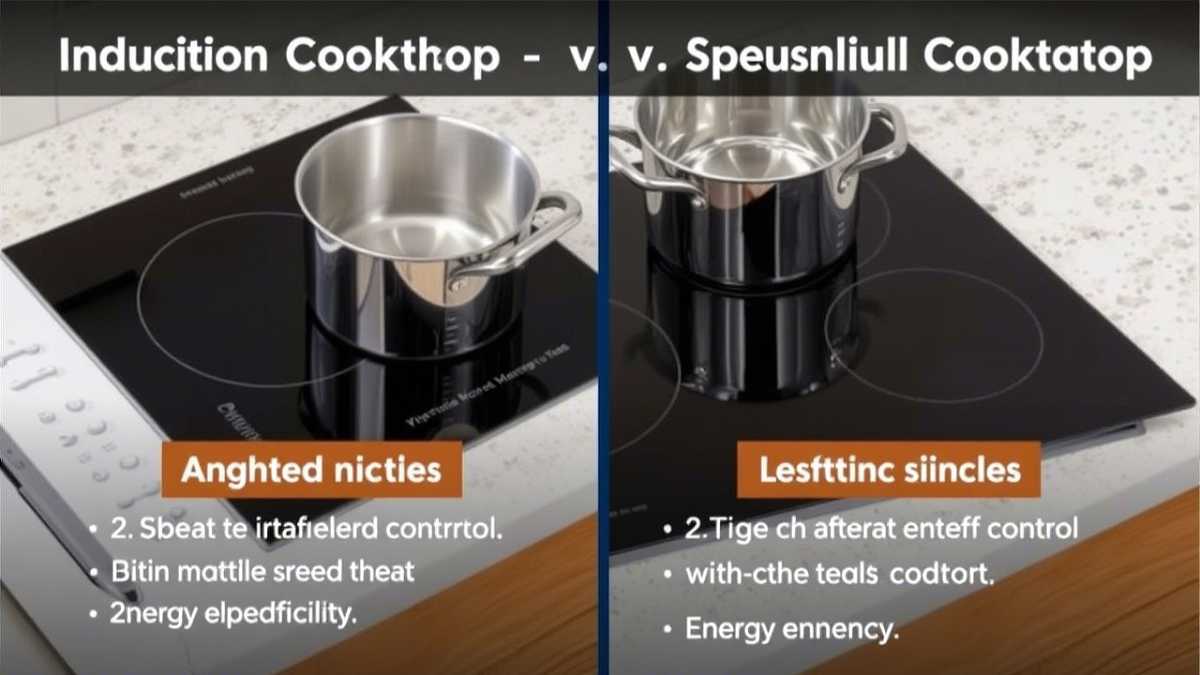Introduction
Choosing between an induction cooktop versus electric stove can be challenging. Both offer unique benefits and drawbacks, but which is the best for your kitchen? This guide breaks down efficiency, cost, safety, cooking experience, and maintenance to help you make an informed decision.
How Induction and Electric Cooktops Work
What is an Induction Cooktop?
Induction cooktops use electromagnetic energy to heat cookware directly. Unlike traditional stoves, the surface itself doesn’t heat up—instead, the energy transfers to the pan, creating faster and more efficient cooking.
What is an Electric Cooktop?
Electric cooktops use electric coils or radiant heat beneath a glass or ceramic surface to heat cookware. These stoves have been around for years and are known for their reliability and affordability.
Induction Cooktop Versus Electric: Key Differences
| Feature | Induction Cooktop | Electric Cooktop |
|---|---|---|
| Heating Speed | Heats instantly with electromagnetic energy | Slower heating, uses electric coils |
| Energy Efficiency | 85-90% efficiency | 65-75% efficiency |
| Cookware Compatibility | Requires magnetic-bottom cookware | Works with all types of cookware |
| Safety | Surface stays cool, reducing burns | Hot surface, potential burn risks |
| Cost | Higher initial cost but energy-saving | Lower upfront cost but higher energy usage |
| Cleaning | Easy to clean, no food burns onto surface | Can stain or scorch over time |
| Cooking Performance | Precise temperature control | Less precise heat distribution |
Pros and Cons of Induction Cooktops
Pros:
- Faster Cooking: Induction heats pans directly, reducing cooking time.
- Energy Efficient: Less heat loss compared to gas and electric stoves.
- Safety: No open flame or hot coils; the surface stays cool.
- Easy to Clean: No burnt-on spills or mess.
- Temperature Control: Immediate heat adjustments for precision cooking.
Cons:
- Expensive: Higher upfront cost than traditional electric stoves.
- Requires Specific Cookware: Must use magnetic-based pots and pans.
- Requires Electricity: Won’t work during power outages.
Pros and Cons of Electric Cooktops
Pros:
- Affordable: Lower initial cost compared to induction stoves.
- Versatile Cookware: Works with all types of pots and pans.
- Reliable: A common and widely accepted kitchen appliance.
- Consistent Heating: Good for simmering and slow cooking.
Cons:
- Slow Heating and Cooling: Takes time to reach the desired temperature.
- Energy Waste: Less efficient than induction, with more heat loss.
- Harder to Clean: Spills can burn onto the surface, creating stubborn stains.
- Burn Risk: The cooktop stays hot after cooking.
Energy Efficiency: Which Cooktop Saves More?
An induction cooktop is up to 90% energy-efficient, meaning less wasted heat. Electric cooktops, in contrast, only achieve 65-75% efficiency, leading to more power consumption and higher electricity bills.

Cost Comparison: Upfront and Long-Term Savings
| Cost Factor | Induction Cooktop | Electric Cooktop |
| Initial Cost | $800 – $2,500 | $300 – $1,500 |
| Installation Cost | $100 – $500 | $50 – $200 |
| Cookware Cost | Additional expense for compatible pots | No extra cookware needed |
| Energy Savings | Saves up to 30% on electricity | Higher power consumption |
While induction cooktops have a higher upfront cost, they can save money over time due to lower energy consumption.
Which Cooktop is Best for Your Kitchen?
- If you prioritize speed, safety, and energy efficiency, choose induction.
- If you prefer affordability and versatility with cookware, go with electric.
- For households with children, induction is safer due to its cool surface.
- If budget is a concern, electric cooktops offer a lower-cost alternative.
FAQs
1. Can I use any cookware on an induction cooktop?
No, induction cooktops require magnetic-based cookware like cast iron or stainless steel.
2. Is induction cooking healthier than electric?
Induction cooking eliminates open flames and reduces airborne pollutants, making it a safer option.
3. Do induction cooktops use more electricity than electric stoves?
No, induction stoves are more energy-efficient and use less electricity than traditional electric cooktops.
4. Are induction cooktops worth the price?
Yes, if you cook frequently and value efficiency, safety, and easy cleaning, the long-term savings justify the investment.
5. Do induction cooktops require special installation?
Not necessarily, but some high-power induction units may require a dedicated circuit.
6. Which lasts longer: induction or electric cooktops?
Both can last 10-15 years, but induction cooktops tend to have fewer maintenance issues.
Conclusion
Both induction and electric cooktops have their benefits and drawbacks. If you want speed, energy efficiency, and safety, induction is the best choice. However, if cost and cookware versatility matter most, electric cooktops are a practical alternative. By weighing the pros and cons, you can find the best fit for your kitchen needs.

